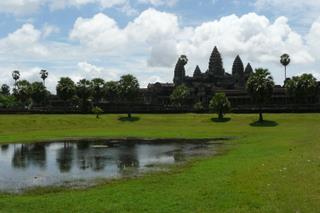If there’s one thing the ancient Khmers knew how to do, it’s build temples. There have been quite a few temples on the way so far, and we were expecting a lot from Angkor Wat, but it still managed to impress. The complex is surrounded by a huge moat, (more like a lake) with a crumbling walkway to the main gate. Inside the outer walls it was still a good few hundred metres walk (a long way in the Cambodian sun) to the temple proper and it’s distinct five towers. Intricate carvings covered most walls, and it was even quiet enough for moments of solitude. With such an impressive stucture it’s easy to see why it was adapted from Hindu to Buddhism over the years.
Angkor Wat is just one of many temples in the ancient city, Ta Phrom is a very atmospheric temple that has been left to the jungle ravages. Stone walls and ceilings have collapsed everywhere, and those still standing are more than likely to have a tree growing on them with it’s roots hanging down the side. If you want see what we are talking about, the movie Tomb Raider has a few scenes set there. After many more temples (I’ll save you the details…) we took a look around the ruins of the city, Angkor Thom, with it’s huge relief walls. The scale of the ancient civilisation is hard to comprehend, but at a time when London had a population of about 50,000, Angkor is believed to have been home to around 1 million.
Inevitably, in a country where incomes are low and every tourist (even us!) is considered rich, there were a abundance of street stalls and children selling bracelets or postcards (for 1 dollar, obviously!). Beyond being annoying with repeated chants of “10 bracelet, 1 dolla”, and “when you come back, you buy from me”, there were the failed attempts at guilt: “if you no buy from me, I cry”, and the sure fire way to get me to walk away: “I saw you first, buy from me!”. Still, it was useful having cold drinks at every stop, and the advantage of high visitor fees is that there were no sellers inside the temples.
Skip to content

Simon & Caroline's World Tour 07/08
or, the long way round to Scotland…